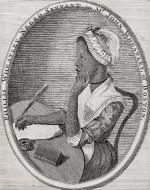Created by Mark Littke on Mon, 05/06/2024 - 04:11
Description:
In this engraved portrait of Phillis Wheatley, an African American woman who was captured and sailed to America and later became a renowned poet, is enjoying the freedom to write her lines and ideas on paper upon her desk with a writing feather in hand. Her left hand is raised toward her cheek, and the moment captured in this portrait of the writer represents a spark or a change. This portrait captures her process to not only start writing a new and inviting piece of poetry, but it also portrays the start of a literary revolution of her time. One can see the rebirth of the Romantic movement of poetry from the death of Neo-Classical era of poetry. This prior era of the Neo-Classical has been defined by rigidly constructed lines with many rules—including iambic pentameter, of course—that contained little expression or a free flow of thoughts. This Romantic movement, beginning in the late 1700s here during Wheatley’s lifetime, is defined by an emphasis on individualism, reverence for the natural world, idealism, passion, and an interest in the mystic or supernatural (“A Brief Guide to Romanticism”). Throughout Wheatley’s collection of poetry, the themes of this movement closely resonate with the pattern of her works.
Looking specifically at her His Excellency General Washington poem of patriotic praise, passion and idealism are particularly notable themes throughout this work. Wheatley internalized, in this poem, a philosophy of an undying love for the land of the New World, and her patriotism for America is often described as overwhelming (Sistrunk). There are two sets of lines in this shorter poem that truly show the contrast from the fallen, strict Neo-Classical era of poetry in the rebirth of the passionate, nature-focused, and individualistic Romantic style of Wheatley’s age. Wheatley expresses, “Astonish'd ocean feels the wild uproar, /The refluent surges beat the sounding shore; /Or think as leaves in Autumn's golden reign” (Wheatley). The theme of nature and mystic harmony of these lines is predominant in Wheatley’s Romantic-movment-appropriate description of the magnitude of George Washington’s contributions to the country. Wheatley also writes and, in the case of the order of the poem’s lines, concludes, “Proceed, great chief, with virtue on thy side, /Thy ev'ry action let the Goddess guide. /A crown, a mansion, and a throne that shine, /With gold unfading, WASHINGTON! Be thine” (Wheatley). At the climax of the poem, the remaining predominant themes of the Romantic movement shine forth in the forms of passion and high praise toward the individual. With these unique ideas and well-rounded approaches to poetry in the example of one work, one can easily understand how Phillis Wheatley was one of the pioneers in revolutionizing poetry through the birth of the expressive Romantic movement of poetry, which shut the door on the popularity of the dying, more formal style of the Neo-Classical that had sparked from the Enlightenment.
Works Cited
“A Brief Guide to Romanticism.” Poets.Org, Academy of American Poets, 27 May 2004, poets.org/text/brief-guide-romanticism.
“Phillis Wheatley.” Wikipedia, Wikimedia Foundation, 3 Feb. 2007, https://commons.wikimedia.org/wiki/File:Phillis_Wheatley_frontispiece.jpg.
Sistrunk, Albertha. “PHILLIS WHEATLEY: AN EIGHTEENTH-CENTURY BLACK AMERICAN POET REVISITED.” CLA Journal, vol. 23, no. 4, 1980, pp. 391–98. JSTOR, http://www.jstor.org/stable/44328590.
Wheatley, Phillis. “His Excellency General Washington.” Poets.Org, Academy of American Poets, 27 June 2019, poets.org/poem/his-excellency-general-washington.
Copyright:
Associated Place(s)
Part of Group:
Featured in Exhibit:
Artist:
- Scipio Moorhead


